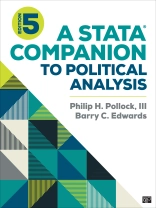The Fifth Edition of A Stata® Companion to Political Analysis by Philip H. Pollock III and Barry C. Edwards teaches your students to conduct political research with Stata, one of the most popular statistical software packages. This workbook offers the same easy-to-use and effective style as the other companions to the Essentials of Political Analysis, to work with Stata versions 12 through 17. With this comprehensive workbook, students analyze research-quality data to learn descriptive statistics, data transformations, bivariate analysis (such as cross-tabulations and mean comparisons), controlled comparisons, correlation and bivariate regression, interaction effects, and logistic regression. The many annotated screen shots, as well as QR codes linking to demonstration videos, supplement the clear explanations and instructions. End-of-chapter exercises allow students to ample space to practice their skills.
The Fifth Edition includes new and revised exercises, along with new and updated datasets from the 2020 American National Election Study, an experiment dataset, and two aggregate datasets, one on 50 U.S. states and one based on countries of the world. A new 15-chapter structure helps break up individual elements of political analysis for deeper explanation while updated screenshots reflect the latest platform.
Mục lục
Figures and Tables
Preface
Introduction: Getting Started with Stata
I.1 Datasets for Stata Companion
I.2 A Quick Tour of Stata
I.3 Running Commands in Stata
I.4 Quick Access to Tutorials and Resources
Chapter 1 Using Stata for Data Analysis
1.1 General Syntax of Stata Commands
1.2 Using Stata’s Graphic User Interface Effectively
1.3 Do-files
1.4 Printing Results and Copying Output
1.5 Customizing Your Display
1.6 Log Files
1.7 Getting Help
Chapter 1 Exercises
Chapter 2 Descriptive Statistics
2.1 Identifying Levels of Measurement
2.2 Describing Nominal Variables
A Closer Look: Weighted and Unweighted Analysis: What’s the Difference?
2.3 Describing Ordinal Variables
2.4 Bar Charts for Nominal and Ordinal Variables
2.5 Describing Interval Variables
A Closer Look: Stata’s Graphics Editor
2.6 Histograms for Interval Variables
2.7 Obtaining Case-Level Information
Chapter 2 Exercises
Chapter 3 Transforming Variables
3.1 Creating Dummy Variables
3.2 Applying Math Operators to Variables
3.3 Managing Variable Descriptions and Labels
3.4 Collapsing Variables into Simplified Categories
3.5 Centering or Standardizing a Numeric Variable
3.6 Creating an Additive Index
Chapter 3 Exercises
Chapter 4 Making Comparisons
4.1 Cross-Tabulation Analysis
A Closer Look: The replace Command
4.2 Mean Comparison Analysis
A Closer Look: The format Command
4.3 Making Comparisons with Interval-Level Independent Variables
Chapter 4 Exercises
Chapter 5 Graphing Relationships and Describing Patterns
5.1 Graphs for Binary Dependent Variables
5.1.1 Simple Bar Charts with Nominal-Level Independent Variables
5.1.2 Area Chart with Ordinal-Level Independent Variables
5.1.3 Graphs with Interval-Level Independent Variables
5.2 Graphs for Nominal-Level Dependent Variables
5.2.1 Clustered Bar Charts with Nominal-Level Independent Variables
5.2.2 Multiple Line Plots with Ordinal-Level Independent Variables
5.2.3 Graphs with Interval-Level Independent Variables
5.3 Graphs for Ordinal-Level Dependent Variables
5.3.1 Using Bars to Represent Select Values
5.3.2 Stacked Bar Chart for Ordinal-Ordinal Relationship
5.3.3 Graphs with Interval-Level Independent Variables
5.4 Graphs for Interval-Level Dependent Variables
5.4.1 Plotting Means with Bars or Lines
5.4.2 Box Plots
5.4.3 Scatterplots
Chapter 5 Exercises
Chapter 6 Random Assignment and Sampling
6.1 Random Assignment
6.1.1 Two Groups with Equal Probability
6.1.2 Multiple Groups with Varying Probabilities
6.1.3 Random Assignment to Predetermined-Size Groups
6.2 Analyzing the Results of an Experiment
6.2.1 Assessing Random Assignment
6.2.2 Evaluating the Effect of Treatment
6.3 Random Sampling
6.3.1 Simple Random Sampling with Replacement
6.3.2 Simple Random Sampling without Replacement
6.3.3 Systematic Random Samples
6.3.4 Clustered and Stratified Random Samples
6.4 Selecting Cases for Qualitative Analysis
6.4.1 Most Similar Systems
6.4.2 Most Different Systems
6.5 Analyzing Data Ethically
6.5.1 Ethical Issues in Data Analysis
6.5.2 Ten Tips for Writing Replication Code
Chapter 6 Exercises
Chapter 7 Making Controlled Comparisons
7.1 Cross-Tabulation Analysis with a Control Variable
7.1.1 Start with a Basic Cross-Tabulation
7.1.2 Controlling for Another Variable
7.1.3 Interpreting Controlled Cross-Tabulations
A Closer Look: The If Qualifier
7.2 Visualizing Controlled Comparisons with Categorical Dependent Variables
7.3 Mean Comparison Analysis with a Control Variable
7.3.1 Start with Basic Mean Comparison Table
7.3.2 Adding Control Variables
7.3.3 Interpreting a Controlled Mean Comparison
7.4 Visualizing Controlled Mean Comparisons
Chapter 7 Exercises
Chapter 8 Foundations of Inference
8.1 Estimating Population Parameters with Simulations
8.2 Expected Shape of Sampling Distributions
8.2.1 Central Limit Theorem and the Normal Distribution
8.2.2 Normal Distribution of Sample Proportions
8.2.3 Normal Distribution of Sample Means
8.2.4 The Standard Normal Distribution
8.2.5 The Empirical Rule (68-95-99 Rule)
8.3 Confidence Interval and Margins of Error
8.3.1 Critical Values for Confidence Intervals
8.3.2 Reporting the Confidence Interval for a Sample Proportions
8.3.2 Reporting the Confidence Interval for a Sample Means
8.4 Student’s t-Distribution: When You’re Not Completely Normal
8.4.1 The t-Distribution’s Role in Inferential Statistics
8.4.1 Critical Values of t-Distributions
Chapter 8 Exercises
Chapter 9 Hypothesis Tests with One and Two Samples
9.1 Role of the Null Hypothesis
9.2 Testing Hypotheses with Sample Proportions
9.2.1 Testing One Sample Proportion Against Hypothesized Value
9.2.2 Testing Difference Between Two Sample Proportions Using Groups
9.2.3 Testing Difference Between Two Sample Proportions Using Variables
9.2.4 Testing Hypotheses about Proportions with Weighted Data
9.3 Testing Hypotheses with Sample Means
9.3.1 Testing One Sample Mean Against Hypothesized Value
9.3.2 Testing the Difference Between Two Sample Means Using Groups
9.3.3 Testing the Difference Between Two Sample Means Using Variables
9.3.4 T-Test Variations from Assumptions about Variance
9.3.5 Testing Hypotheses about Means with Weighted Data
Chapter 9 Exercises
Chapter 10 Chi-Square Test and Analysis of Variance
10.1 The Chi-Square Test of Independence
10.1.1 How the Chi-Square Test Works
10.1.2 Conducting a Chi-Square Test
10.1.3 Example with Nominal-Level Independent Variable
A Closer Look: Chi-Square Test with Weighted Data
10.1.4 Reporting and Interpreting Results
A Closer Look: Other Applications of Chi-Square Tests
10.2 Measuring the Strength of Association between Categorical Variables
10.2.1 Lambda
10.2.2 Somers’ D
10.2.3 Cramer’s V
10.3 Chi-Square Test and Measures of Association in Controlled Comparisons
10.3.1 Analyzing an Ordinal-Level Relationship with a Control Variable
10.3.2 Analyzing a Nominal-Level Relationship with a Control Variable (and Weighted Observations)
10.4 Analysis of Variance (ANOVA)
10.4.1 How ANOVA Works
10.4.2 Single Factor ANOVA
10.4.3 Two Factor ANOVA
10.4.4 Stata’s F-Distribution Functions
Chapter 10 Exercises
Chapter 11 Correlation and Bivariate Regression
11.1 Correlation Analysis
11.1.1 Correlation between Two Variables
11.1.2 Correlation Among More than Two Variables
A Closer Look: Other Types and Application of Correlation Analysis
11.2 Bivariate Regression Analysis
A Closer Look: Treating Census as a Sample
A Closer Look: R-Squared and Adjusted R-Squared: What’s the Difference?
11.3 Creating a Scatterplot with a Linear Prediction Line
A Closer Look: Creating Graphs with Multiple Layered Elements
A Closer Look: What If a Scatterplot Doesn’t Show a Linear Relationship?
11.4 Correlation and Bivariate Regression Analysis with Weighted Data
A Closer Look: Creating Tables of Regression Results
Chapter 11 Exercises
Chapter 12 Multiple Regression
12.1 Multiple Regression Analysis
12.1.1 Estimating and Interpreting a Multiple Regression Model
12.1.2 Visualizing Multiple Regression with Bubble Plots
12.1.3 Multiple Regression with Weighted Observations
12.2 Regression with Multiple Dummy Variables
12.2.1 Estimating and Interpreting Regression with Multiple Dummy Variables
12.2.2 Changing the Reference Category
12.2.3 Visualizing Regression with Multiple Dummy Variables
12.3 Interaction Effects in Multiple Regression
12.3.1 Estimating Regression Model with Interaction Term
12.3.2 Graphing Linear Prediction Lines for Interaction Relationships
Chapter 12 Exercises
Chapter 13 Analyzing Regression Residuals
13.1 Expected Values, Observed Values, and Regression Residuals
13.1.1 Example from Bivariate Regression Analysis
13.1.2 Residuals from Multiple Regression Analysis
13.2 Squared and Standarized Residuals
13.2.1 Squared Residuals
13.2.2 Standardized Residuals
13.3 Assumptions about Regression Residuals
13.4 Analyzing Graphs of Regression Residuals
13.4.1 Histogram of Regression Residuals
13.4.2 Residual Diagnostic Plots
13.5 Testing Regression Assumptions with Residuals
13.5.1 Testing Assumption that Residuals are Normally Distributed
13.5.2 Testing the Constant Variance Assumption
15.3.3 Regression Diagnostics for Multiple Regression Analysis
A Closer Look: Other Regression Diagnostic Tests
13.6 What If You Diagnose Problems with Residuals?
Chapter 13 Exercises
Chapter 14 Logistic Regression
14.1 Odds, Logged Odds, and Probabilities
14.2 Estimating Logistic Regression Models
14.2.1 Logistic Regression with One Independent Variable
14.2.2 Reporting and Interpreting Odds Ratios
14.2.3 Evaluating Model Fit
A Closer Look: Logistic Regression Analysis with Weighted Observations
14.3 Logistic Regression with Multiple Independent Variables
14.4 Graphing Predicted Probabilities with One Independent Variable
14.4.1 Interval-Level Independent Variable
14.4.2 Categorical Independent Variable
A Closer Look: Marginal Effects and Expected Changes in Probability
14.5 Graphing Predicted Probabilities with Multiple Independent Variables
14.5.1 One Categorical and One Interval-Level Independent Variable
14.5.2 Two Categorical Independent Variables
A Closer Look: Stata’s Quiet Mode
14.5.3 Plotting Predicted Probabilities with atmeans Option
14.5.4 Combining atmeans and over Options
Chapter 14 Exercises
Chapter 15 Doing Your Own Political Analysis
15.1 Doable Research Ideas
15.1.1 Political Knowledge and Interest
15.1.2 Self-Interest and Policy Preferences
15.1.3 Economic Performance and Election Outcomes
15.1.4 Electoral Turnout in Comparative Perspective
15.1.5 Correlates of State Policies
15.1.6 Religion and Politics
15.1.7 Race and Politics
15.2 Getting Data into Stata
15.2.1 Opening Stata Formatted Datasets
15.2.2 Importing Microsoft Excel Datasets
15.2.3 Using HTML Table Data
15.2.4 Entering Data with Stata’s Data Editor
15.3 Writing It Up
15.3.1 The Research Question
15.3.2 Previous Research
15.3.3 Data, Hypotheses, and Analysis
15.3.4 Conclusions and Implications
Chapter 15 Exercises
Appendix
Table A-1: Variables in the Debate Dataset in Alphabetical Order
Table A-2: Variables in the GSS Dataset in Alphabetical Order
Table A-3: Variables in the NES Dataset in Alphabetical Order
Table A-4: Variables in the States Dataset by Topic
Table A-5: Variables in the World Dataset by Topic
Giới thiệu về tác giả
Barry C. Edwards writes textbooks and works for Fair Trial Analysis, LLC, a company that conducts research on juries and jurors for civil and criminal litigation. He received his B.A. from Stanford University, a J.D. from New York University, and a Ph.D. from the University of Georgia. He taught survey design and analysis, research methods, and prelaw courses at the University of Central Florida and continues to teach occasional courses for the University of Georgia. His political science interests include American politics, public law, and research methods. He founded the Political Science Data Group and created the Poli Sci Data.com website. His research has been published in American Politics Research, Congress & the Presidency, Election Law Journal, Emory Law Journal, Georgia Bar Journal, Harvard Negotiation Law Review, Journal of Politics, NYU Journal of Legislation and Public Policy, Political Research Quarterly, Presidential Studies Quarterly, Public Management Review, State Politics and Policy Quarterly, and UCLA Criminal Justice Law Review.












